The immediate ancestors of
humans were members of the genus Australopithecus
![]() . The
australopithecines
. The
australopithecines
![]() (or australopiths) were intermediate between apes and
people. Both australopithecines and humans are biologically similar enough
to be classified as members of the same biological tribe--the
Hominini
(or australopiths) were intermediate between apes and
people. Both australopithecines and humans are biologically similar enough
to be classified as members of the same biological tribe--the
Hominini
![]() . All people, past and present, along with the
australopithecines are hominins
. All people, past and present, along with the
australopithecines are hominins
![]() . We share in common not only the fact that we
evolved from the same ape ancestors in Africa but that
both genera are habitually bipedal
. We share in common not only the fact that we
evolved from the same ape ancestors in Africa but that
both genera are habitually bipedal
![]() , or two-footed, upright
walkers. By comparison, chimpanzees, bonobos, and gorillas are primarily
quadrupedal
, or two-footed, upright
walkers. By comparison, chimpanzees, bonobos, and gorillas are primarily
quadrupedal
![]() , or
four-footed.
, or
four-footed.
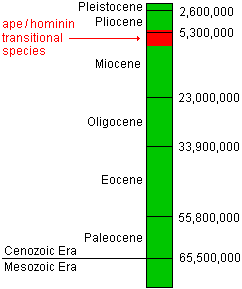 |
|
Over the
last decade, there have been a number of important fossil discoveries in
Africa of what may be very early transitional ape/hominins, or
proto-hominins. These creatures lived
just after the divergence from our common
hominid ancestor
with chimpanzees and bonobos, during the late Miocene and early Pliocene
Epochs. The fossils have been tentatively classified as members of
three distinct genera--Sahelanthropus
![]() ,
Orrorin
,
Orrorin
![]() , and
Ardipithecus
, and
Ardipithecus
![]() .
Sahelanthropus was the earliest, dating 7-6 million years ago.
Orrorin lived about 6 million years ago, while Ardipithecus
remains have been dated to 5.8-4.4 million years ago. At present, the
vote is still out as to whether any of these three primates were in fact
true hominins and if they were our ancestors. The classification of Sahelanthropus has been
the most in question.
.
Sahelanthropus was the earliest, dating 7-6 million years ago.
Orrorin lived about 6 million years ago, while Ardipithecus
remains have been dated to 5.8-4.4 million years ago. At present, the
vote is still out as to whether any of these three primates were in fact
true hominins and if they were our ancestors. The classification of Sahelanthropus has been
the most in question.
The
earliest australopithecines very likely did not evolve until 5 million years
ago or shortly thereafter (during the beginning of the Pliocene Epoch) in East
Africa. The primate fossil record for this crucial transitional
period leading to australopithecines is still scanty and somewhat confusing. However, by about 4.2 million years ago, unquestionable
australopithecines were present. By 3 million years ago, they were
common in both East and South Africa. Some have been found dating to
this period in North Central Africa also. As the australopithecines
evolved, they exploited more types of environments. Their early proto-hominin ancestors had been predominantly tropical forest animals.
However, African forests were progressively giving way to sparse woodlands
and dry
grasslands, or savannas
![]() . The
australopithecines took advantage of these new conditions. In the more
open environments, bipedalism would very likely have been an advantage.
. The
australopithecines took advantage of these new conditions. In the more
open environments, bipedalism would very likely have been an advantage.
By 2.5 million years ago, there were at least 2 evolutionary lines of hominins descended from the early australopithecines. One line apparently was adapted primarily to the food resources in lake margin grassland environments and had an omnivorous diet that increasingly included meat. Among them were our early human ancestors who started to make stone tools by this time. The other line seems to have lived more in mixed grassland and woodland environments, like the earlier australopithecines, and was primarily vegetarian. This second, more conservative line of early hominins died out by 1 million years ago or shortly before then. It is likely that all of the early hominins, including humans, supplemented their diets with protein and fat rich termites and ants just as some chimpanzees do today.
|
Major early |
|
 |
History
of Discovery
In his 1871
book entitled The Descent of Man, and Selection in Relation to Sex, Charles Darwin speculated that
fossils of the earliest humans and their immediate progenitors ultimately would be found somewhere in
Africa. He based this on the fact that the natural range of our nearest
living relatives, chimpanzees and gorillas, is limited
to Africa. He
concluded that we ultimately must have shared a now extinct common ancestor with those
apes in Africa. This view was mostly rejected by the scientific world of
the time. Before
the 1920's, knowledge of our fossil ancestors only went back to the
Neandertals
![]() in
Europe and some
presumably earlier human-like forms from Java, in Southeast Asia. Few researchers were willing to estimate
the time period of the earliest hominins at much more than 100,000 years, and there was no
inkling of anything older from Africa. In addition, there was a bias among the
predominantly European paleoanthropologists against accepting early Africans as the ancestors of all
humanity.
in
Europe and some
presumably earlier human-like forms from Java, in Southeast Asia. Few researchers were willing to estimate
the time period of the earliest hominins at much more than 100,000 years, and there was no
inkling of anything older from Africa. In addition, there was a bias among the
predominantly European paleoanthropologists against accepting early Africans as the ancestors of all
humanity.
 |
|
| Raymond Dart
(1893-1989) |
|
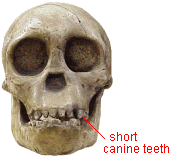 |
| "Taung child"
reconstruction (Australopithecus africanus) |
In
1924, Raymond Dart, an Australian anatomy professor at the University of Witerwatersrand
in Johannesburg, South Africa, obtained a fossil skull that had been blasted out of a
nearby limestone quarry at Taung
![]() . It took him 73
days to chisel the skull free from its surrounding stone matrix and 4 years of
spare time to free the jaw and the fossilized brain. However, long before then, Dart recognized the
importance of this find. In 1925 he named it
Australopithecus africanus
. It took him 73
days to chisel the skull free from its surrounding stone matrix and 4 years of
spare time to free the jaw and the fossilized brain. However, long before then, Dart recognized the
importance of this find. In 1925 he named it
Australopithecus africanus
![]() (literally
"southern ape from Africa"). Because of its small size, he called it the
"Taung baby." In fact, its teeth indicate that it was a 3-4
year old child.
Despite its relatively small brain, he
concluded that this species was intermediate between apes and humans. He based this
mainly on the shape and position of the base of the brain cast. It
indicated that the foramen magnum
(literally
"southern ape from Africa"). Because of its small size, he called it the
"Taung baby." In fact, its teeth indicate that it was a 3-4
year old child.
Despite its relatively small brain, he
concluded that this species was intermediate between apes and humans. He based this
mainly on the shape and position of the base of the brain cast. It
indicated that the foramen magnum
![]() , or hole in the skull through which the spinal cord
passes, pointed downward and
was nearly at the central balance point of the skull. This meant that
the Taung child must have been bipedal. In addition, the
canine
, or hole in the skull through which the spinal cord
passes, pointed downward and
was nearly at the central balance point of the skull. This meant that
the Taung child must have been bipedal. In addition, the
canine
![]() teeth were relatively short. In both of these traits, the Taung child
was much more like a human than an ape. Most paleoanthropologists in the 1920's rejected Dart's claims that
Australopithecus africanus was intermediate between apes and humans in favor of the view that it was just an
ape. Dart's claims were not widely accepted until the late 1940's.
teeth were relatively short. In both of these traits, the Taung child
was much more like a human than an ape. Most paleoanthropologists in the 1920's rejected Dart's claims that
Australopithecus africanus was intermediate between apes and humans in favor of the view that it was just an
ape. Dart's claims were not widely accepted until the late 1940's.
 |
|
| Robert Broom (1866-1951) |
|
Following Dart's discovery, several other caves were investigated in South Africa. Most of the work was done by Robert Broom from 1936 through the 1940's. Broom was a medical doctor and an enthusiastic amateur paleontologist from Scotland. In 1903, he was appointed professor of geology at the University of Stellenbosch in South Africa and became internationally respected for his studies of early mammal-like reptiles. His insistence on the correctness of the theory of evolution led to his dismissal from this conservative religious university in 1910. Consequently, he returned to being a medical doctor in a rural town in South Africa but continued paleontological research in his spare time. In 1934, at the age of 68, he retired from his medical practice and joined the staff of the Transvaal Museum in Pretoria as a paleoanthropologist. The rest of his life was spent searching for early hominin fossils.
Robert Broom's most important discoveries were made in
the Sterkfontein valley of South Africa. It was there in 1936 that he found
the first known adult Australopithecus africanus while excavating in
Sterkfontein
![]() cave. In
1938, he discovered more fossil remains
of africanus and other early hominins in
Kromdraai
cave. In
1938, he discovered more fossil remains
of africanus and other early hominins in
Kromdraai
![]() cave. Some
of these fossils were larger boned and more
muscular with
powerful jaws. Broom named them
Paranthropus robustus
cave. Some
of these fossils were larger boned and more
muscular with
powerful jaws. Broom named them
Paranthropus robustus
![]() (Paranthropus
means "parallel to man"). Significantly, these robust hominins also differed in having
a
sagittal crest
(Paranthropus
means "parallel to man"). Significantly, these robust hominins also differed in having
a
sagittal crest
![]() , or ridge of bone
extending from front to back, along the midline of the top of the skull. A sagittal crest serves as an anchor attachment for exceptionally large, strong jaw muscles.
This skeletal feature is also present in large apes but not in africanus
or humans.
, or ridge of bone
extending from front to back, along the midline of the top of the skull. A sagittal crest serves as an anchor attachment for exceptionally large, strong jaw muscles.
This skeletal feature is also present in large apes but not in africanus
or humans.
|
Australopithecus africanus |
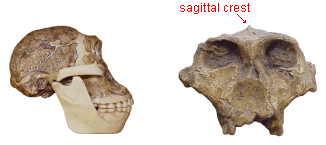 |
Paranthropus robustus |
||
NOTE: Some paleoanthropologists lump Paranthropus robustus and other paranthropoids into the genus Australopithecus. They consider them to be a physically robust subgroup of australopithecines.
In 1948, Robert Broom found more
paranthropoid fossils at
Swartkrans
![]() cave
in South Africa. Following that excavation, he dedicated the rest of
his life to writing everything known about all of the early hominins.
He
completed this compendium work in 1951. He was 85 years old and ill.
As he finally finished his writing, he reportedly said "now it is done and
so am I." He died a few minutes later.
cave
in South Africa. Following that excavation, he dedicated the rest of
his life to writing everything known about all of the early hominins.
He
completed this compendium work in 1951. He was 85 years old and ill.
As he finally finished his writing, he reportedly said "now it is done and
so am I." He died a few minutes later.
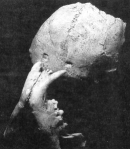 |
|
|
Leopard canines fit |
Between 1965 and 1983, Swartkrans cave was carefully reinvestigated by another South African paleoanthropologist, C. K. Brain, using more thorough field and laboratory techniques than had been used by Robert Broom a generation earlier. Many thousands of bone fragments, including the remains of 130 individual hominins, were recovered by Brain. These bones were from australopithecines and paranthropoids as well as early members of our genus, Homo. Because many of the bones had chewing marks and at least one of the skulls had peculiar depressions reminiscent of punctures made by the canine teeth of a leopard, Brain hypothesized that some of the Swartkrans hominins had been eaten by these big cats. The early hominin fossil-bearing strata in the cave also contained 195 stones that were from locations distant from the cave. Brain believed that 30 of them may have been used as tools or weapons. In any case, the presence of these stones suggests that not all of the early hominins in the cave were there as a result of being the victims of carnivores.
Unfortunately, most of the South African sites where early hominin fossils have been found are not easily dated because they lack association with volcanic deposits that would readily allow radiometric dating. That is not the case with most of the early hominin sites in East Africa.
The
oldest fossil hominins have been recovered from sites in East Africa, especially in the
Great Rift Valley. One of the most
important sites there is
Olduvai Gorge
![]() . It is an approximately 30 mile
(48 km.) long, eroded canyon complex cutting into the Serengeti
. It is an approximately 30 mile
(48 km.) long, eroded canyon complex cutting into the Serengeti
![]() Plain in Northern
Tanzania. It is only about 295 feet (90 m.) deep, but its neatly stratified layers of dirt and
rock interspersed with easily datable volcanic ash and lava layers cover the last
2.1 million years of geological and evolutionary history. The remains
of many australopithecines, paranthropoids, and early humans have been found at Olduvai. When these ancient
hominins lived there, it was a lake margin grassland area that had abundant
plant food and meat sources that could be exploited by scavenging.
Plain in Northern
Tanzania. It is only about 295 feet (90 m.) deep, but its neatly stratified layers of dirt and
rock interspersed with easily datable volcanic ash and lava layers cover the last
2.1 million years of geological and evolutionary history. The remains
of many australopithecines, paranthropoids, and early humans have been found at Olduvai. When these ancient
hominins lived there, it was a lake margin grassland area that had abundant
plant food and meat sources that could be exploited by scavenging.
 |
|
|
Mary and Louis Leakey
with |
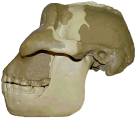 |
|
| Zinjanthropus boisei (Paranthropus boisei) |
|
Early
hominin fossils from Olduvai Gorge are known mostly as a result of the many expeditions of
Louis and Mary
Leakey
![]() . Louis began searching there in 1931, and his
second wife Mary
joined him in 1935. However, it was not until 1959 that they found their first
early hominin fossil. Louis gave it a new genus and species designation,
Zinjanthropus
boisei
. Louis began searching there in 1931, and his
second wife Mary
joined him in 1935. However, it was not until 1959 that they found their first
early hominin fossil. Louis gave it a new genus and species designation,
Zinjanthropus
boisei
![]() (literally "East African
man"). Subsequently, it was recognized to be only a super robust
paranthropoid. It is now generally referred to as
Paranthropus
boisei
(literally "East African
man"). Subsequently, it was recognized to be only a super robust
paranthropoid. It is now generally referred to as
Paranthropus
boisei
![]() .
Using the then new potassium-argon dating method, the fossil was determined to
be 1.75
.25 million years old.
This was a startlingly early date when it was made public in 1959. Louis Leakey and
Zinjanthropus
instantly became international media stars, and both of their pictures were
on the front page of newspapers around the world. Louis was also the
focus of several television documentary programs. In the years after
his death in 1972, Mary became well known as a paleoanthropologist in her
own right.
.
Using the then new potassium-argon dating method, the fossil was determined to
be 1.75
.25 million years old.
This was a startlingly early date when it was made public in 1959. Louis Leakey and
Zinjanthropus
instantly became international media stars, and both of their pictures were
on the front page of newspapers around the world. Louis was also the
focus of several television documentary programs. In the years after
his death in 1972, Mary became well known as a paleoanthropologist in her
own right.
NOTE: Louis Leakey gave his Zinjanthropus find the species name boisei in honor of Charles Boise, a wealthy American who funded fieldwork by the Leakeys.
In 1974, a team
of paleoanthropologists, under the direction of an American,
Donald Johanson, found an even
more ancient
species of australopithecine at the
Hadar
![]() site in the
Afar
site in the
Afar
![]() Desert region of Northern Ethiopia. It was a
40% complete skeleton of an adult female whom they named
Lucy. She had
been only 3 feet 3 inches (1 m.) tall with a slender body weighing only about 60 pounds
(27 kg.). She lived 3.2-3.18 million years
ago. Johanson concluded that Lucy was from a different species than had been
previously discovered. He classified her as an
Australopithecus afarensis
Desert region of Northern Ethiopia. It was a
40% complete skeleton of an adult female whom they named
Lucy. She had
been only 3 feet 3 inches (1 m.) tall with a slender body weighing only about 60 pounds
(27 kg.). She lived 3.2-3.18 million years
ago. Johanson concluded that Lucy was from a different species than had been
previously discovered. He classified her as an
Australopithecus afarensis
![]() (named for the Afar region).
Many other specimens of this species and later ones were found in Ethiopia
since 1974, but none is as complete as Lucy.
(named for the Afar region).
Many other specimens of this species and later ones were found in Ethiopia
since 1974, but none is as complete as Lucy.
 |
"Lucy" skeleton (Australopithecus afarensis) |
|
|
 |
|
|
Early
hominin footprints |
|
About 30 miles
south of Olduvai Gorge in Northern Tanzania is the
Laetoli
![]() site. It was investigated in the late 1930's by Louis and Mary Leakey, but no fossil hominins were found
at that time. Mary Leakey returned to Laetoli with Tim White, an American paleoanthropologist
in 1978. They found bones of what
were likely Australopithecus afarensis dating 3.7-3.5 million years
ago (several hundred thousand years older than Lucy). They also found 59 footprints of bipedal hominins (presumably afarensis)
in a now hardened volcanic ash layer. These individuals walked in two close parallel tracks across
volcanic dust at least 3.5 million years ago. The footprints look almost like those of
modern humans. They are narrow with a low arch, and they clearly show that the big toe
was in line with the others. These are all traits of humans but not of apes.
Based on the characteristics of the footprints, Mary Leakey concluded that their makers were adults
who were 4 feet 9 inches and 4 feet 1 inch tall and that they walked parallel
to each other in a strolling fashion with
relatively short strides. In addition, there are a child's footprints
within those of the larger adult.
site. It was investigated in the late 1930's by Louis and Mary Leakey, but no fossil hominins were found
at that time. Mary Leakey returned to Laetoli with Tim White, an American paleoanthropologist
in 1978. They found bones of what
were likely Australopithecus afarensis dating 3.7-3.5 million years
ago (several hundred thousand years older than Lucy). They also found 59 footprints of bipedal hominins (presumably afarensis)
in a now hardened volcanic ash layer. These individuals walked in two close parallel tracks across
volcanic dust at least 3.5 million years ago. The footprints look almost like those of
modern humans. They are narrow with a low arch, and they clearly show that the big toe
was in line with the others. These are all traits of humans but not of apes.
Based on the characteristics of the footprints, Mary Leakey concluded that their makers were adults
who were 4 feet 9 inches and 4 feet 1 inch tall and that they walked parallel
to each other in a strolling fashion with
relatively short strides. In addition, there are a child's footprints
within those of the larger adult.
|
This link takes you to a video at an external website. To return here, you must click the "back" button on your browser program. (length = 3 mins, 20 secs) |
 |
|
|
The "Black Skull" |
In
northern Kenya and southern Ethiopia, there is an arid region around
Lake Turkana
![]() in the Great Rift
Valley that has exposed geological deposits dating to at least 4.3 million
years ago.
Richard Leakey, the
son of Mary and Louis Leakey, began looking for hominin fossils there in the
late 1960's. During the 1970's, his team of field researchers from the
National Museum of Kenya made a number of important finds, including fossils
of early humans who will be described in the next tutorial
of this series.
in the Great Rift
Valley that has exposed geological deposits dating to at least 4.3 million
years ago.
Richard Leakey, the
son of Mary and Louis Leakey, began looking for hominin fossils there in the
late 1960's. During the 1970's, his team of field researchers from the
National Museum of Kenya made a number of important finds, including fossils
of early humans who will be described in the next tutorial
of this series.
While working on the western side of Lake Turkana in 1985, an American paleoanthropologist named Alan Walker made an important discovery. This was a nearly complete paranthropoid skull with an unusually large sagittal crest and some features reminiscent of the more ancient Australopithecus anamensis (described below). Manganese in the soil deposit where it was located stained it black. As a result, this unusual fossil has become known as the "black skull." It has been classified as Paranthropus aethiopicus (named after Ethiopia). Since it dates to 2.5 million years ago, it is a prime candidate for being the earliest paranthropoid species.
In
1995,
Meave Leakey, the
wife of Richard Leakey, began discovering bones of a very early
australopithecine species at several sites southwest of Lake Turkana. She named it
Australopithecus anamensis
![]() ("anam" is "lake" in the Turkana
language). The
dentition of this hominin seems to be transitional between apes and
later australopithecines. This fits with the 4.2-3.9 million year dates
for the volcanic ash associated with the anamensis fossils. The
shapes of the arm and leg bones of this species indicate that it was
bipedal. Anamensis is currently the earliest known
australopithecine species. Bones from at least 8 more anamensis
skeletons have been found in Ethiopia.
("anam" is "lake" in the Turkana
language). The
dentition of this hominin seems to be transitional between apes and
later australopithecines. This fits with the 4.2-3.9 million year dates
for the volcanic ash associated with the anamensis fossils. The
shapes of the arm and leg bones of this species indicate that it was
bipedal. Anamensis is currently the earliest known
australopithecine species. Bones from at least 8 more anamensis
skeletons have been found in Ethiopia.
In 1996, Berhane Asfaw, an Ethiopian researcher, and Tim White found a 2.5
million year old
hominin fossil
in the Middle Awash Valley of Ethiopia that remains problematical. The
skull characteristics are similar in some ways to Australopithecus
afarensis, but it lived several hundred thousand years after that
species had presumably ended. Asfaw named his new hominin,
Australopithecus garhi
![]() ("garhi" is "surprise" in one of the languages of the Afar Desert region).
Whether or not garhi was a late afarensis, a variant of
africanus, or a distinct species is not clear. Associated with the
remains of garhi were animal bones with what appear to be cut marks
made by simple stone tools. If they were using such tools, this
is remarkable because only early humans have heretofore been associated with
stone tool making.
("garhi" is "surprise" in one of the languages of the Afar Desert region).
Whether or not garhi was a late afarensis, a variant of
africanus, or a distinct species is not clear. Associated with the
remains of garhi were animal bones with what appear to be cut marks
made by simple stone tools. If they were using such tools, this
is remarkable because only early humans have heretofore been associated with
stone tool making.
In 2001, Meave Leakey announced the discovery of a 3.5-3.2 million year old hominin skull from the west side of Lake Turkana. She suggested that this fossil may displace Lucy (Australopithecus afarensis) as the progenitor of humans. Meave named it Kenyanthropus platyops ("flat-faced man of Kenya"). This hominin lived during the same time period as Lucy. However, it had a comparatively large, flat face and smaller teeth. The latter characteristic suggests that Kenyanthropus regularly ate softer foods than did Lucy. However, it is not yet clear where this new discovery fits within our evolution. Some paleoanthropologists have suggested that it is only a variant of Australopithecus afarensis.
Recent Discoveries
In 2006, Tim White, now a professor at the University of California, Berkeley, announced the discovery of bones from at least 8 Australopithecus anamensis individuals dating to 4.1 million years ago in what had been a woodland environment in the Awash Valley of Ethiopia. In 2009, White and his team of researchers announced the discovery of a 4.4 million year old ape/transitional species named Ardipithecus ramidus that also lived in woodland environments of the Awash Valley. White believes that this very early species was the direct ancestors of Australopithecus afarensis.
|
This link takes you to a video at an external website. To return here, you must click the "back" button on your browser program. (length = 10 mins) |
In 2010, Lee Berger of the University of the Witwatersrand in Johannesburg, South Africa announced his discovery of two partial skeletons of what may be a new australopithecine species that lived 1.977 million years ago in South Africa. He named it Australopithecus sediba ("sediba" means "fountain" or "wellspring" in the seSotho language of South Africa). Berger and his colleagues suggest that this new species may be descended from Australopithecus africanus and could be one of the last links in the evolutionary line between the australopithecines and our genus Homo.
|
describes key fossils and their potential importance. This link takes you to a video at an external website. To return here, you must click the "back" button on your browser program. (length = 3 mins, 4 secs) |
NOTE: Our understanding of early hominins was led astray at the beginning of the 20th century as a result of the discovery by Charles Dawson in 1912 of a fossil skull in England that became known as the Piltdown man. It had a large brain case similar to modern humans but an ape-like jaw. This fit with the popular but incorrect assumption that our early ancestors would have ape-like bodies and human-like brains. The discovery of australopithecines in South Africa beginning in 1924 showed that the early hominins were actually just the reverse―they had almost human-like bodies below the neck but brains that were very little changed in size from those of apes. It was not until the early 1950's that the Piltdown man skull was exposed for what it really was, a clever fraud. This realization came as a result of close examination by independent researchers and fluorine analysis dating.